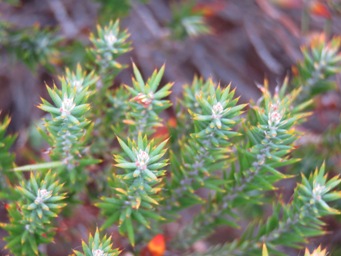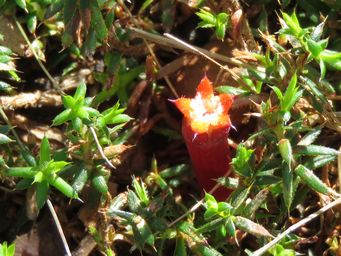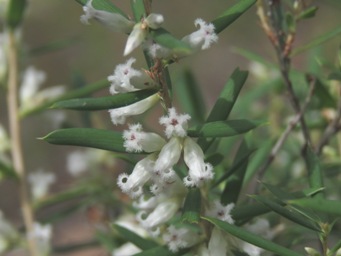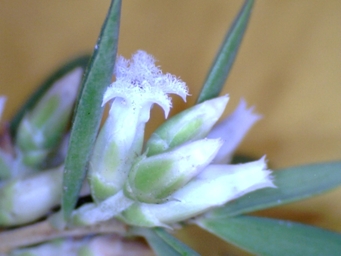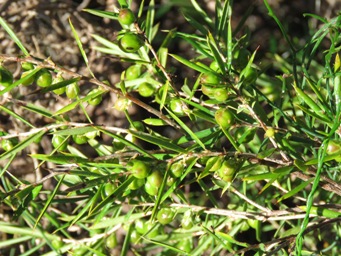Australia So Much to See
Copyright (C) 2013 AustraliaSoMuchtoSee.com. All reights reserved
Sources used for identification of wildflowers shown on these pages and regions where they occur see Credits
These pages will
feature some of the wildflowers we have photographed in Western Australia, and where possible, identified. If you
are able to help identify further flowers, or correct any I may have wrong, please contact us.
Information given for each species
will give botanical name, known common names, describe the flower, give time of year it flowered, and where it was photographed, and
the areas it occurs in. Names have been matched to Florabase which has also been used to show distribution.
Styphelia. Due to reclassifications, a number of my listed wildflowers have been moved into the Styphelia genus (2020). This includes all the Astroloma species, and some of the Leucopogon species.


Styphelia pallida 2020, formerly Astroloma pallidum, Kick Bush.
Tiny white heath flowers with a slight bottle shape with
a five petaled star at the point, prostrate plant, prickly leaves
Late spring, summer
Bridgetown, South West Region, Western
Australia and occurs through the Mid West, Coastal Wheatbelt, Perth, South West, and Great Southern Regions.
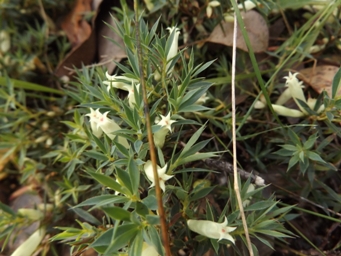
Styphelia erectifolia 2020, formerly Astroloma drummondii Moss-leafed Heath, Candle Cranberry (above)
Tiny red candle shaped flowers, semi-prostrate
plant, tiny leaves with a spine at the tip
Autumn
Bridgetown, South West Region, Western Australia. Species found through the South
West from Perth to Albany.
Styphelia discolor 2020, formerly Astroloma ciliatum, Candle Cranberry, Mull (which applied to a number of species).
Tiny
red candle shaped flowers with a five petaled star at the point, prostrate plant, prickly leaves with spines down the sides
and a spine on the tip
Autumn-Winter
Bridgetown, South West Region, Western Australia. Species found in coastal areas from Eneabba
to Esperance, and inland through the South West, Great Southern, Perth, and some of Wheatbelt regions.
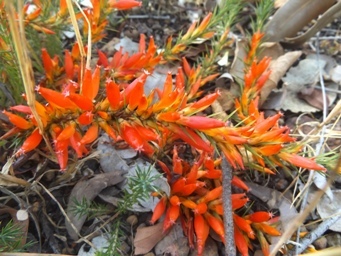


Styphelia serratifolia 2020, formerly Astroloma serratifolium, Kondrung (or Condrun).
A shrub with small red tubular flowers. Small
broad pointed ended leaves with sharp serrations on edges and a thorn at the point. These leaves curl back at the tip.
November
Kulin and occurs through the Mid West, Wheatbelt, and Great Southern Regions, and into the Goldfields.
The pink flowering plant
at right was found near Hyden in the Wheatbelt Region
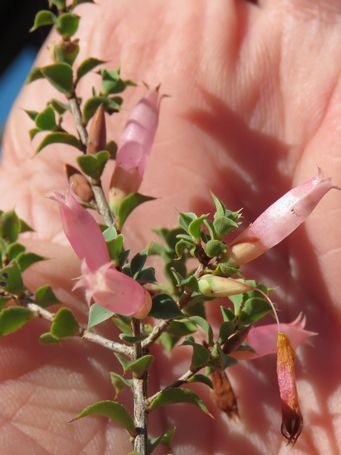
Styphelia propinqua 2020, formerly Leucopogon propinquus. Tiny white flowers with five furry petals on tubular flowers
in clusters on a medium to tall shrub with sharp pointed leaves. Seed pods (technically known as drupes as a fleshy
fruit around the seed).
Late summer and Autumn
Bridgetown, South West Region, Western Australia and found through the Wheatbelt,
South West and Great Southern regions.
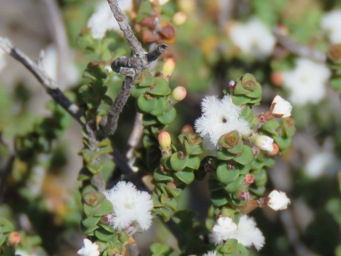
Styphelia hamulosa 2020, (formerly Leucopogon hamulosus)
A shrub with small typical Leucopogon flute shaped flowers, with five fluffy
petals at the tip. Foliage consists of small leaves along the stems, which are as wide as they are long, but terminating in
a point with a backward turning small hook (photo above right), which gives this species is name. In Latin, hamulosus means
“beset with small hooks”. Large nuts from the previous season above right
November
Dragon Rocks Nature Reserve, Newdegate, Wheatbelt
region, Western Australia, and can be found through the Mid West, Wheatbelt and parts of the Goldfield region, extending towards the
south coast between Ravensthorpe and Esperance

Stypandra glauca, Blind Grass, Nodding Blue Lily, Graceful Blue Lily
A small six petalled flower with six prominent yellow stamens.
Flowers droop downwards, in groups on stems amongst and above the bunched grass-like foliage. Eating the plant is thought to
send sheep blind.
October
Mayanup (Boyup Brook), South West region, Western Australia and can be found through the Mid West,
Wheatbelt, Perth, South West, Great Southern and Goldfield regions.
